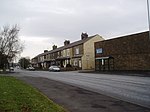Noyna Hill

Noyna Hill (sometimes just called "Noyna" or "Noyna Rock/s") is a hill in the Pennines hills range in Pendle, Lancashire, England. It is located a mile to the east of Foulridge and it is possible to see other local towns such as Colne, Nelson, Trawden, Barnoldswick and Earby. On a clear day most of Lancashire and the Yorkshire Dales are seen from here. Although the prominence is not that great due to the close proximity of other hills, it is unique in the area for having a large wide, but not very high rocky outcrop that is distinctive and well known in the area. The hill is 122m, (400 ft) above the village of Foulridge. The hill is on farmland, but has public footpaths that allow access.
Excerpt from the Wikipedia article Noyna Hill (License: CC BY-SA 3.0, Authors, Images).Noyna Hill
Noyna Road, Borough of Pendle Foulridge
Geographical coordinates (GPS) Address Nearby Places Show on map
Geographical coordinates (GPS)
| Latitude | Longitude |
|---|---|
| N 53.879 ° | E -2.15 ° |
Address
Noyna Road
Noyna Road
BB8 7QW Borough of Pendle, Foulridge
England, United Kingdom
Open on Google Maps










